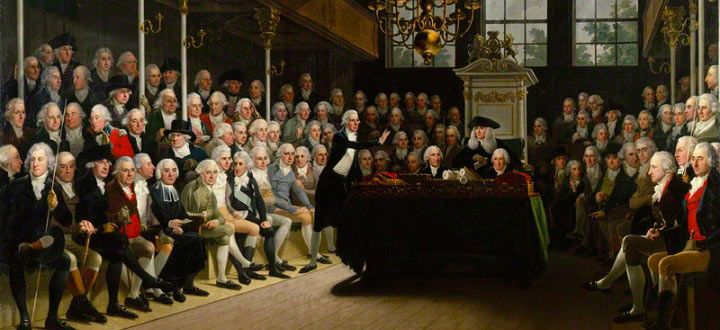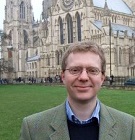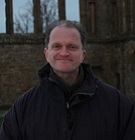Casting new light on the lost birthplace of British political debate
-
Research
- Culture and Communication
- Creativity
Posted on 22 September 2015
A little-known building that sat at the heart of royal and political life at Westminster for centuries has been brought back to life with the help of digital technology

There’s a detective story in here about how some pretty challenging archival information can be transformed with the help of emerging technologies”
In 1834, a fire swept through the Palace of Westminster destroying a sizeable chunk of British history and reducing many of the medieval buildings to smoking ruins.
One of the most badly damaged areas was the upper floor of the 13th century St Stephen’s Chapel. The Chapel, once a lavishly decorated place of royal worship, was also home to Britain’s first dedicated parliamentary debating chamber, the forerunner to today’s House of Commons.
Architectural traces
Few architectural traces of the original building remain. But researchers at York are currently sifting through precious archives to recreate the long-lost medieval masterpiece in an ambitious project which combines centuries-old documents with the latest digital technology.
“Some of our most prominent political figures honed their debating skills in St Stephen’s including Pitt the Younger and Sir Robert Peel,” explained Dr John Cooper from our Department of History who is leading the project.
“It sat at the heart of public life for hundreds of years and echoes of the physical layout of the building can still be seen in the House of Commons. For instance, during debates in St Stephen’s Chapel, the Members sat facing each other across the floor – a layout that persists today.”
The £1 million three-year St Stephen’s project explores key moments in the building’s history in a bid to answer long-standing academic questions – and tackle some myths – about its place in the development of Britain’s rich parliamentary heritage.
"We want to generate a sense of wonder and amazement about a stunning medieval royal chapel that might now be lost, but whose influence certainly lives on,” says Dr Cooper.
Animations
One of the project’s most important public legacies is a series of computer animations which recreate the colours, textures and atmosphere of the building as it evolved from a magnificently decorated site of royal worship to its more functional use as a parliamentary debating chamber.
The work, funded by the Arts and Humanities Research Council (AHRC) with a contribution from the University, is directed by Professor Tim Ayers in our History of Art department. The University’s Centre for the Study of Christianity and Culture is bringing the digital reconstruction to life with the latest modelling techniques.
Watch one of the films here:
The project involves meticulous examination of historical records, surviving fragments and art works in search of historical and architectural clues.
The team are also drawing on knowledge and expertise from within the Palace of Westminster itself where they work closely with officials in charge of archives and art collections.
Archival gold dust
One of the richest seams of evidence is the building’s fabric accounts, now in The National Archives at Kew. Painstakingly prepared by medieval scribes, they list the building materials and workers’ wages while the building was under construction over 70 years from 1292.
At over 640 feet long, the accounts are some of the most extensive for any building in medieval Europe. They are archival gold dust for the project team, informing the work of two doctoral students, as well as the virtual reconstruction. The task of transcribing and translating the extensive documents from Latin is the subject of a separate Leverhulme-funded project led by Tim Ayers, assisted by Dr Maureen Jurkowski from University College London.
“The accounts record the people responsible for a building of great magnificence, naming masons, sculptors, painters, glaziers and armies of workmen, but also their suppliers. In the period before and after the Black Death, they offer exceptional insights into medieval crafts and working practices. They are also a direct link to the lost building”, says Professor Ayers.
As a result of the project, Dr Cooper is now a veteran of Parliamentary committees where he has discussed the history of the extraordinary buildings currently under examination at York. He has also delivered presentations in Tours, Beijing and Vancouver.
The project could also influence more contemporary debates about the multi million pound repair and refurbishment programme currently the subject of much discussion at the Palace of Westminster.
More than decoration
“Our research shows that architecture, history, power and the dignity and the sovereignty of Parliament are all bound up within these buildings. The building has so many historical and political resonances – our project deals with a whole lot more than decoration,” says Dr Cooper.
The finished project will be a valuable educational resource for history and history of art scholars, but Dr Cooper hopes the project will also open up the story of St Stephen's to a wider audience.
“There’s a detective story in here about how some pretty challenging archival information can be transformed with the help of emerging technologies."
The text of this article is licensed under a Creative Commons Licence. You're free to republish it, as long as you link back to this page and credit us.

Dr John Cooper
Research centres on the Tudor monarchs - their policies in church and state and the relationship between court and country

Professor Tim Ayers
Research interests in British art and architecture of the later middle ages
Discover the details
Find out more on the project website St Stephen's Chapel Westminster Visual and Political Culture 1292 to 1941
Follow the project on Twitter @VSS_Project
Explore the work of the Arts and Humanities Research Council
Find out more about the history of the Commons Chamber on Parliament’s Living Heritage site
Visit the departments
Explore more research

A research project needed to spot trees on historic ordnance survey maps, so colleagues in computer science found a solution.

We’re using gaming technology to ensure prospective teachers are fully prepared for their careers.

A low cost, high-accuracy device, could play a large part in the NHS's 'virtual wards'.

